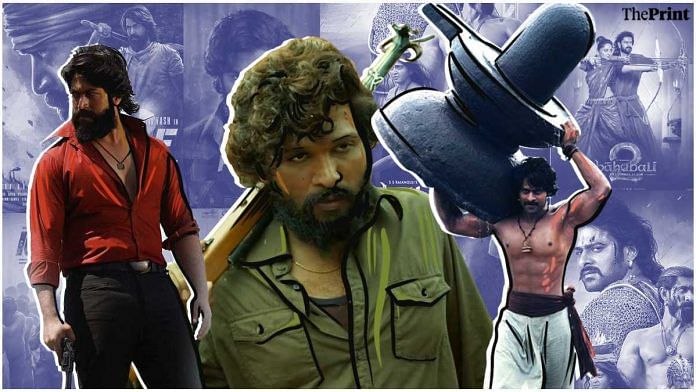This seems to be the era of multipart movies in regional cinema, as two big franchises, Pushpa and K.G.F. have broken box office records. While the first part of the Allu Arjun-starrer Pushpa was released on 17 December 2021, the second part of KGF was released on 14 April 2022. Both drew massive crowds despite Covid.
The attempt is to create a cinematic universe, inspired by Marvel and DC movies, which have been consistently creating an interlaced world of superheroes, especially since the 2010s. Be it the Avengers or Justice League or even the Harry Potter franchise, multi-part movies have been the rage in recent times. It offers a continuity, more adventures and ultimately, helps in creating larger-than-life characters who are never ordinary.
Director Rohit Shetty also seems to have taken a cue and is creating a cop cinematic universe in Bollywood. While Hindi cinema is just catching up, 2021-22 showed the South is already cashing in on the trend.
Also read: Allu Arjun’s Pushpa shows Telugu films have pan-India audience. Step aside, Bollywood
Economy of multi-part films
For starters, multi-part films have the element of suspense and a cliffhanger. This is a strategy most effective in TV and OTT series, which is being effectively deployed in movies too. The trend went big with S.S. Rajamouli’s Baahubali, with the film ending with ‘Why did Katappa kill Bahubali?’ It was a hook for the audience to come watch the second part.
It was literally the national question until the next part was released. From memes to YouTube videos, it became a fever that would not subside and contributed to the massive opening and total earnings of the film.
Pushpa’s Hindi version crossed the Rs 100-crore mark while the Yash-starrer K.G.F. Chapter 2, has surpassed the lifetime collections of Baahubali The Beginning and collected Rs 676 crore, across all languages.
Eventually, the economy of the multi-part movie is what prompts filmmakers to create ‘sagas’ that span over two years. It is almost a given that when the next part of a franchise is about to be released, one would rewatch the previous parts of the franchise. This, even if film rights are sold to a satellite TV channel or OTT platform, means raking in further profits. Also when it comes to screen time, a second part means you can make a story longer, waste less time establishing characters and allow for subplots. It’s a win-win for the actors and screenwriters too.
Also read: Naradan on Amazon Prime Video has all that makes Malayalam cinema a worthy watch
Men tell the stories
One noticeable feature of multi-part films is that the lead is inevitably a man, and a star who is ‘bankable’. Be it Prabhas, Allu Arjun or Yash, the stars are chosen with much deliberation. The star power ensures people remain loyal fans of the movies, even if they are released after a gap of two or more years. Women rarely lead multi-part movies.
The other element is, of course, the fact that we are now a generation with much less attention span. A Lagaan—its runtime was 3 hours, 44 minutes—would not work in today’s day and age, despite it featuring India’s national obsession: cricket. The runtime decides whether a film is hit or not. Multi-part films offer the benefit of not cutting down on the storytelling time.
With the pandemic shutting down movie halls, people turned to OTT platforms and got even more used to the idea of shorter forms of entertainment, which may however extend in terms of seasons or parts. Multi-part movies seem to be a natural path.
Of course, movies by themselves are not likely to ever go out of fashion. But if one can earn twice the amount, with the story being told in parts, why not? Whether some movies should even have more than one part or even that one part, is another question. But for now, this is a formula that seems economically viable, especially for regional cinema and in all likelihood, it is here to stay.
Views are personal.



